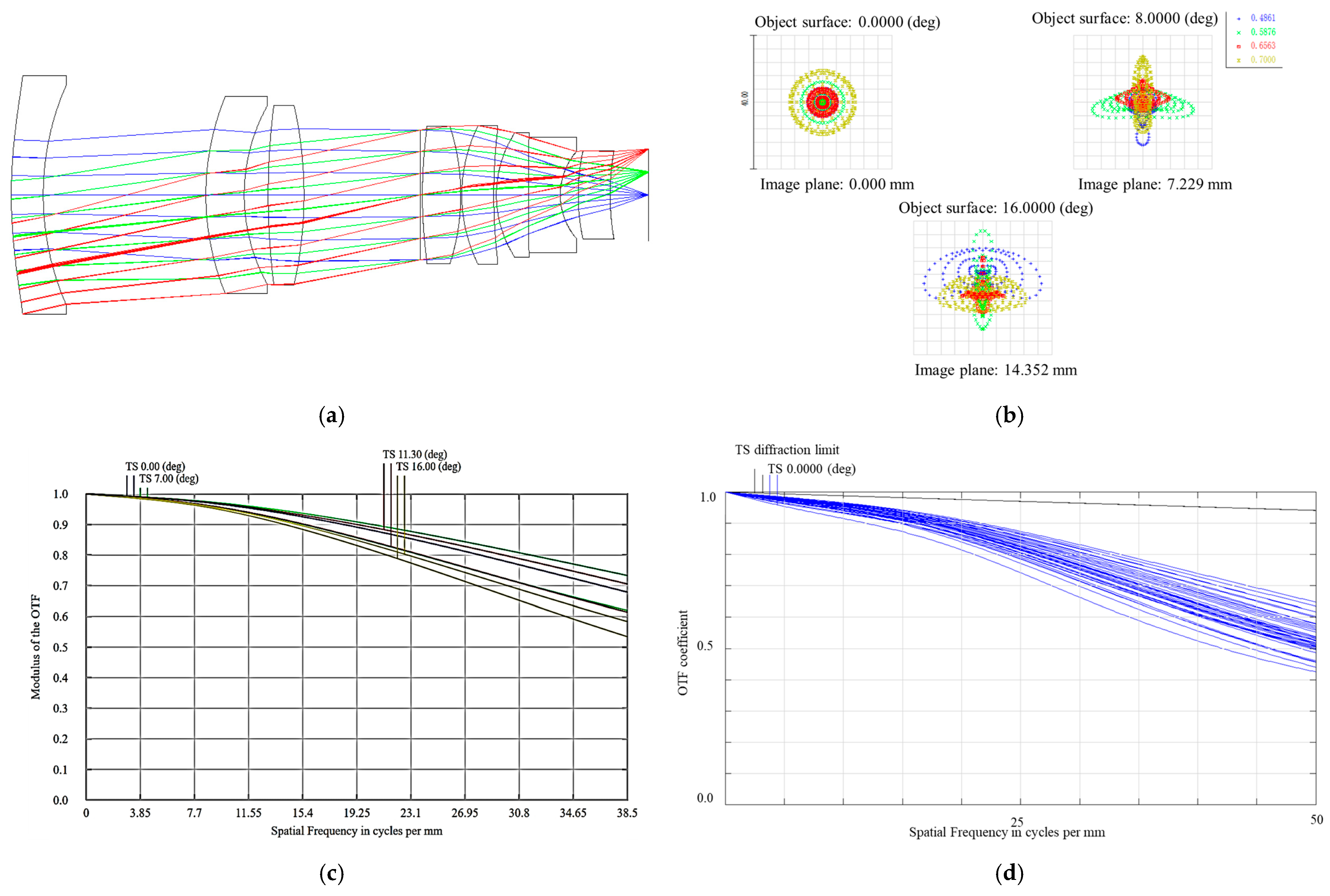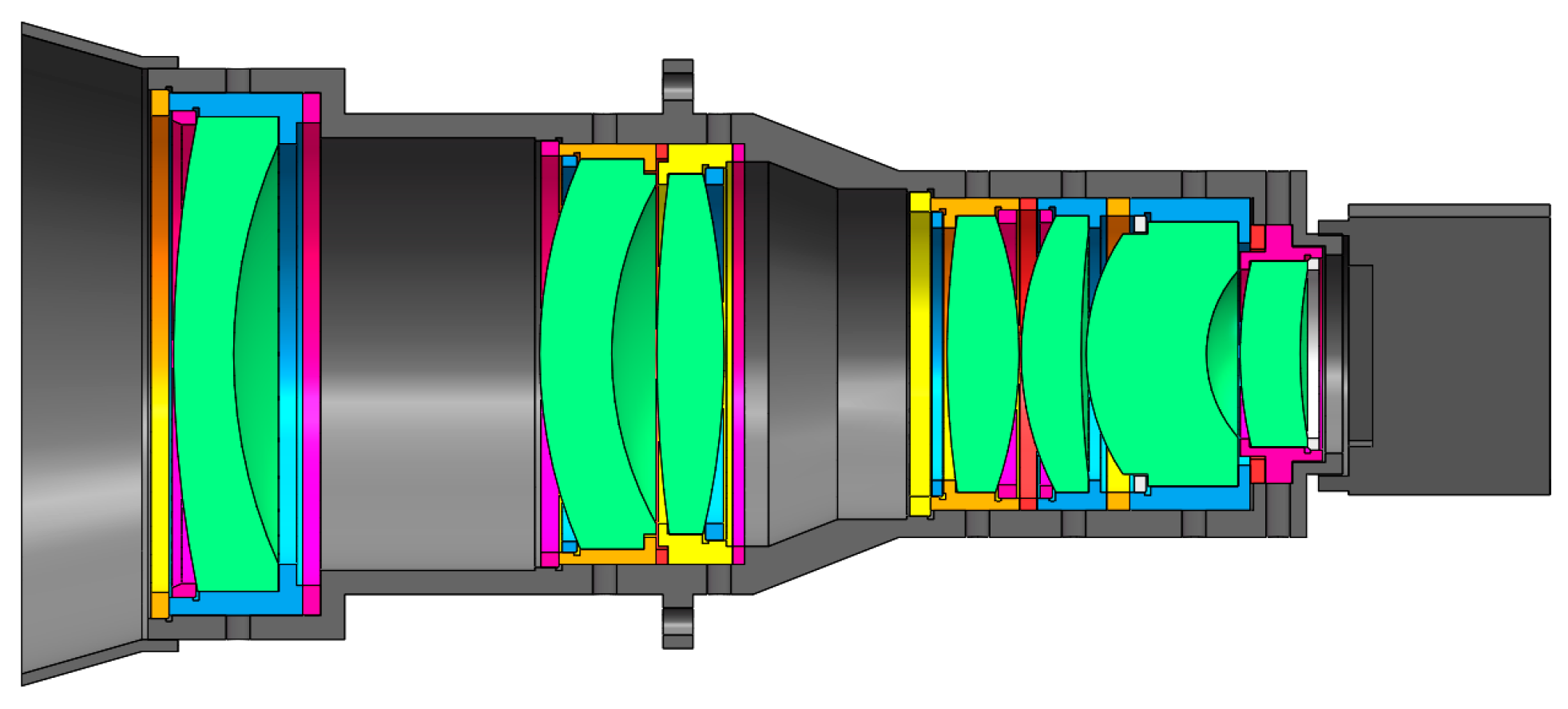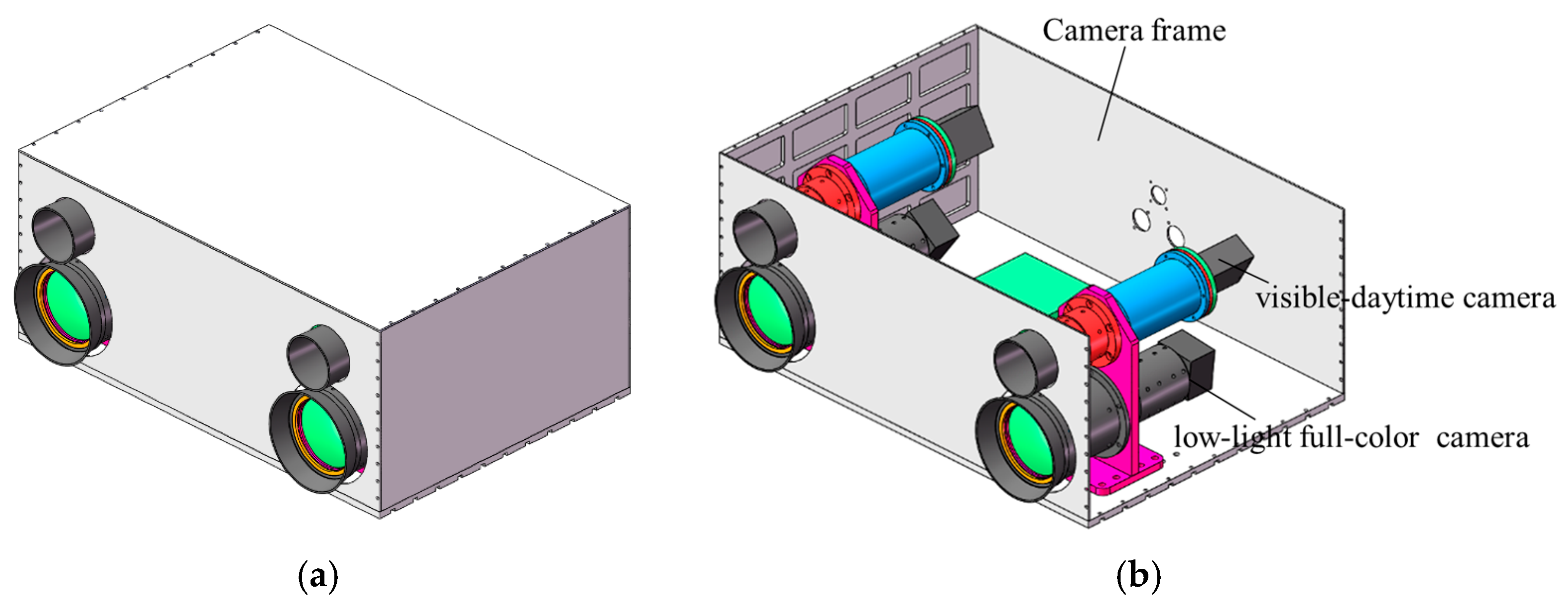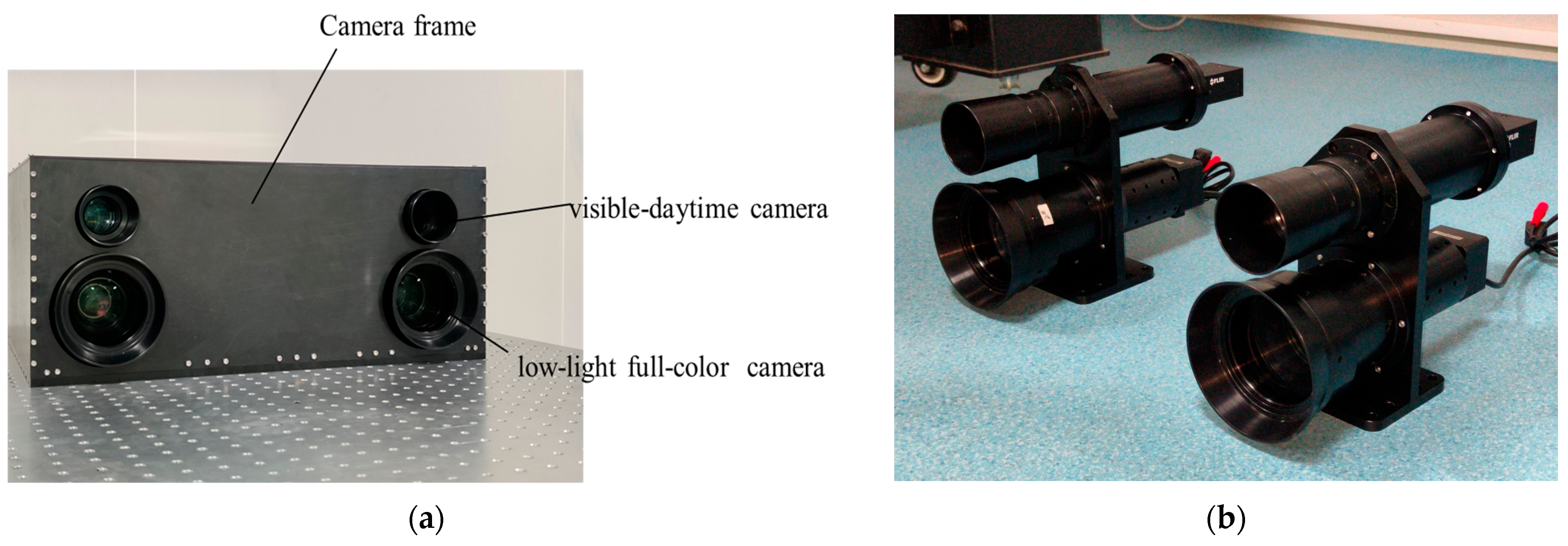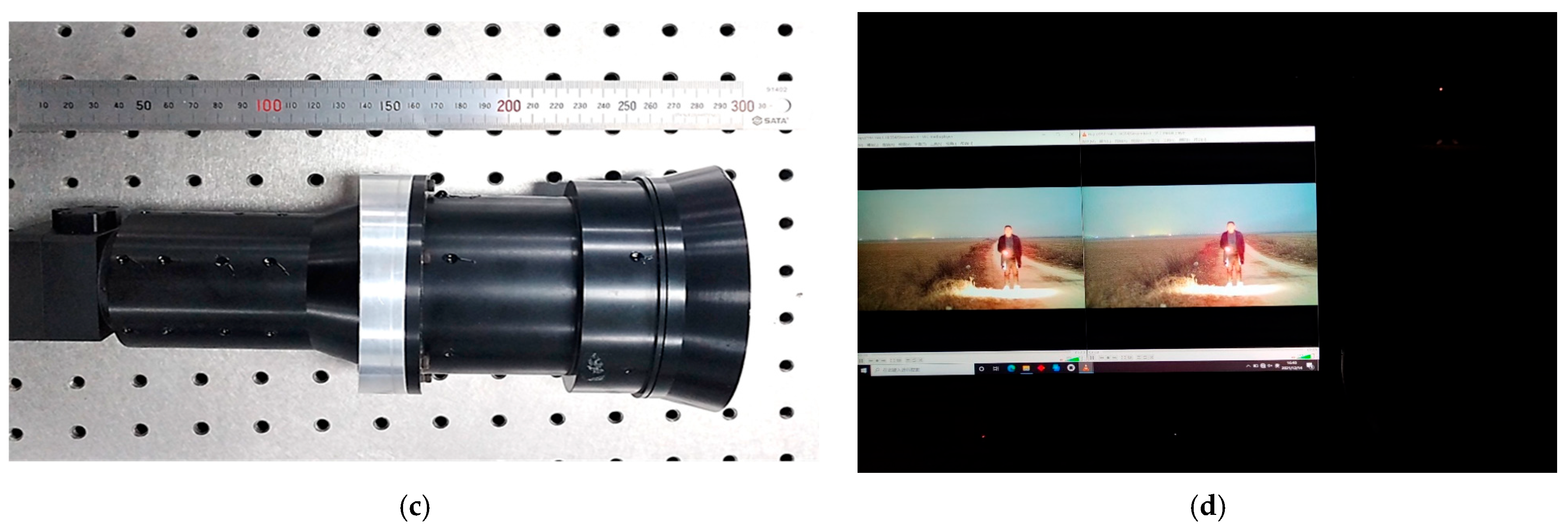1. Introduction
Visual perception dominates human interaction with the external world, accounting for nearly 80% of the information processed by the human brain during environmental cognition and decision-making [
1]. Accordingly, optical imaging systems—ranging from compact cameras to large-scale remote sensing platforms—have become indispensable tools across a wide range of domains, including environmental monitoring, security surveillance, autonomous driving, biomedical diagnostics, and scientific exploration [
2,
3,
4,
5,
6]. These systems serve as artificial “eyes”, converting radiance into measurable signals to support both human interpretation and machine understanding. Over recent decades, significant advances have been made in sensor technologies, lens design, and computational imaging algorithms. High-resolution visible-band cameras now deliver stunning detail and color accuracy under daylight conditions. However, their performance degrades rapidly with declining illumination. Standard visible-light imaging systems exhibit poor signal-to-noise ratios (SNRs) under low-light or night-time conditions, often resulting in nearly black, detail-deficient images [
7,
8,
9].
To address the limitations of visible-light imaging in darkness, near-infrared (NIR) and image-intensified night vision systems have been widely adopted [
10,
11,
12,
13,
14]. These systems enhance sensitivity by capturing longer wavelengths or amplifying faint incoming photons through photocathodes and microchannel plates. However, this comes at the cost of spectral fidelity, since their outputs are predominantly monochrome or pseudo-colored. As such, they fail to preserve the true appearance of the scene—color contrasts, material cues, and object textures—which are critical in tasks such as target recognition, camouflage detection, and visual interpretation in complex environments.
In response, multi-modal and hybrid imaging systems have been proposed, combining visible, NIR, and thermal channels into a single device. While such systems can provide complementary information under diverse lighting and environmental conditions, they also introduce considerable system complexity. Challenges include sensor co-registration, chromatic aberration across bands, real-time data fusion, and additional computational latency. Moreover, they often require active illumination sources (e.g., IR LEDs), increasing their power consumption and making them susceptible to detection or interference in covert scenarios. This persistent dichotomy between daytime clarity and night-time visibility has hindered the achievement of a truly universal imaging system capable of maintaining high spatial resolution, natural color reproduction, and low-noise performance across the full range of lighting conditions. This capability is critically needed in applications demanding uninterrupted situational awareness, e.g., the 24 h surveillance of sensitive zones, unmanned aerial vehicle (UAV) reconnaissance, marine monitoring, and low-light field biology.
Here, we present a dual-mode visible imaging system that seamlessly transitions between high-resolution daytime and high-sensitivity night-time full-color operation within a single opto-mechanical assembly. The upper module comprises a matched pair of visible daytime cameras, each equipped with a 155 mm focal-length lens and a 6° field of view (FOV), optimized for long-range, high-resolution color imaging under daylight conditions. The lower module consists of a matched pair of low-light cameras featuring 55 mm focal-length, f/1.5 lenses with a 32° FOV, designed to maximize photon throughput and maintain color integrity under low-light illumination, with measured illuminance as low as 0.0009 lux. By co-registering these two optical chains within a unified housing and synchronizing their readout and control electronics, our system delivers continuous, full-color imagery with a wider FOV from bright noon through moonless dusk—addressing the longstanding challenge of uninterrupted, natural-color visual sensing across the entire day–night cycle.
The main contributions in this work can be summarized as follows:
- (1)
Pure visible-band, full-color continuity: Existing UAV/Surveillance Dual-Lens solutions almost invariably pair a visible-band (day) camera with an IR or thermal imager for nights. These systems switch to monochrome or pseudo-color IR at dusk, losing true-color fidelity. Only our system uses two visible-band optical chains, each optimized for its illumination regime, and maintains full-color rendition from bright sunlight all the way down to 0.0009 lux—without any IR source or post-fusion.
- (2)
Ultra-high sensitivity with minimalist low-light optics: Prior “low-light” visible cameras rely on image intensifiers, IR illumination, or large multi-element objectives to achieve starlight-level imaging. Our micro-light module uses a single aspheric lens group directly coupled to a low-noise sCMOS sensor, achieving an f/1.5 52 mm optical path that delivers MTF > 0.5 at 38.5 lp/mm and full-color capture at 0.0009 lux. This minimalist design eliminates bulky intensifier tubes, relay optics, and high-voltage electronics, yielding a level of integration and noise performance that is not found in existing EO-payloads or security cameras.
- (3)
Field-expandable FOV and long-range imaging: Typical wide-FOV low-light cameras sacrifice telephoto reach in order to gather photons; conversely, long-focus visible cameras fail at night. By combining a 155 mm f/6 telephoto channel (6° FOV) with a 52 mm f/1.5 wide channel (32° FOV) in one opto-mechanical design, we deliver both high-resolution long-range monitoring and broad-area situational awareness—without mechanical zoom or sensor switching.
2. Designs and Methods
The visible daytime camera employs a square 11.264 mm × 11.264 mm sensor; each one is equipped with 5.5-µm pixel, which sets the Nyquist cutoff frequency at 90.9 lp/mm to avoid aliasing. Its spectral sensitivity is tailored to 450–650 nm to coincide with the silicon photodiode quantum efficiency peak, ensuring maximal photon detection in the visible band. To preserve the full sensor-limited resolution, the lens MTF is specified to be ≥0.5 at 90.9 lp/mm, guaranteeing that optical contrast does not become a system bottleneck. The focal length
f is calculated as follows:
where
l and
h are the length and width dimensions of the sensor, respectively.
Given the primacy of spatial resolution for long-range daytime observation and the need to limit system mass, an f/6 aperture was designed to balance diffraction, aberration control, and mechanical compactness. Finally, the optical layout is designed to be unvignetted—i.e., with a vignetting coefficient of zero—so that the full 6° FOV receives uniform illumination without peripheral light fall-off.
2.1. Design of Visible Daytime Camera
2.1.1. Optical Design of Visible Daytime Camera
As shown in
Figure 1, our visible daytime camera adopts a six-group, six-element layout (
Figure 1a), with the first surface serving as the aperture stop; the system is configured for a 155 mm focal length, an f/6 speed, a 6° full field of view, and a design wavelength band of 486–656 nm. The spot diagrams in
Figure 1b demonstrate that the root-mean-square (RMS) radii remain well within the Airy disk across the field (0.615 µm at the center, 0.786 µm at mid-field, and 1.028 µm at the edge). The modulation transfer function (MTF) curves plotted in
Figure 1c closely approach the diffraction limit, achieving a contrast better than 0.58 at the Nyquist spatial frequency of 90.9 lp/mm. Finally, the tolerance analysis for the on-axis MTF (
Figure 1d) indicates a nominal value of 0.58 at 90.9 lp/mm, a best-case value of 0.61, and an average of 0.40. All manufactured samples exceed 0.40, which confirms that our design retains adequate contrast under expected fabrication and assembly tolerances.
2.1.2. Structural Design of Visible Daytime Camera
The visible daytime camera consists of a total of 6 coaxial optical lens elements, and its structural design is shown in
Figure 2. The lenses are fixed using a method commonly used in aerospace, which involves clamping with a retaining ring and lens frame. When inserting each lens into the frame, a circumferential adhesive is applied for bonding with the lens frame, and then the retaining ring is tightened for fixation. Each lens undergoes centering processing to ensure that the optical axis coincides with the central axis of the structural frame. The optical spacing between the lenses is maintained by the use of spacers in between. In addition, to ensure the imaging quality of the lens, an aperture and a lens hood have also been designed. The interface for the detector adopts a standard C-mount design, but since the back focal length of the lens is much greater than the flange distance of the standard C-mount, an adapter tube is designed to securely connect the detector to the lens. By adjusting the thickness of the spacers in front of the detector, it is ensured that the detector is positioned at the focal plane of the lens.
2.2. Design of Low-Light Full-Color Camera
2.2.1. Optical Design of Low-Light Full-Color Camera
As shown in
Figure 2, the low-light full-color camera exploits a seven-group, eight-element architecture with a sixth-order aspheric surface on the first element of the front group to reduce the element count and weight while preserving image fidelity (
Figure 3a). The system is configured for a 52 mm focal length, f/1.5 speed, and 32° full FOV over the 480–700 nm band. Its spot diagrams (
Figure 3b) demonstrate root-mean-square radii of 5.15 µm on-axis, 5.90 µm at mid-field, and 6.86 µm at the edge—all comfortably below the pixel pitch—indicating that optical blur remains sub-pixel across the field. The MTF curves in
Figure 3c show that the lens delivers better than 0.5 modulation at 38.5 lp/mm, meeting the system’s resolution requirements under low-light illumination. The tolerance analysis of the on-axis MTF (
Figure 3d) yields a nominal contrast of 0.62 at 38.5 lp/mm, a best-case contrast of 0.62, and an average contrast of 0.54, with more than 80% of manufactured samples exceeding 0.49—confirming that the aspheric-enabled design maintains adequate performance under realistic fabrication and assembly variations.
2.2.2. Structural Design of Low-Light Full-Color Camera
As illustrated in
Figure 4, the low-light full-color lens assembly consists of a total of six optical lenses, among which one lens is a cemented lens. The low-light full-color lens includes Lens Groups 1–7, an outer compression ring for Lens Group 1, spacer 1, an outer compression ring for Lens Group 2, spacer 2, spacer 3, an outer compression ring for Lens Group 4, spacer 4, spacer 5, spacer 6, a tube, and the hood, detector, and fastening screws. The structural design of the lens group adopts a method commonly used in aerospace, where the compression ring and lens frame are tightly fixed. Each lens is glued along the circumference to bond with the lens frame during assembly and then secured with a compression ring. Each lens must undergo centering processing to ensure that the optical axis coincides with the central axis of the structural frame, and the optical spacing between lenses is maintained by the spacers in between. In addition, to enhance the imaging quality of the camera, an aperture and lens hood have also been designed. The detector is connected to the tube via threads, allowing for the adjustment of the front and back distance of the lens group, and then the position of the detector is fixed using fastening screws to achieve the optimal position adjustment of the detector.
3. Imaging System
3.1. Subcomponent Structural Design
To achieve the system functionality, a visible daytime camera and a low-light full-color lens are installed on the same bracket, with the visible daytime camera mounted on top and the low-light full-color mounted below. The height spacing of the two cameras is reasonably adjusted to be as compact as possible for easy installation, in order to reduce the system’s size and weight, as illustrated in
Figure 5.
3.2. System Structural Design
The box assembly is shown in
Figure 6, with four holes opened on the front panel to facilitate the lens group extending out of the box for image acquisition. The processing board is mounted between the two lens groups to achieve power supply and data transmission for the lens group, while the back cover plate is equipped with electrical structures and data interfaces. The box assembly also features a reasonable lightweight design to reduce the weight of the system. The 3D structure and cross-sectional diagrams of the system are described in
Figure 6a,b.
3.3. System Setup and Sub-Aperture Setup
As illustrated in
Figure 7a, the overall dimensions of the system are 516 mm × 390 mm × 220 mm, with a designed weight of 10 kg. As illustrated in
Figure 7b, the frames, compression rings, and isolation rings of the four lenses are made of aluminum alloy 2A12T4 material. The two lens brackets are also constructed from aluminum alloy 2A12T4. In
Figure 7a, the box is made up of six black POM boards spliced together, which significantly reduces the overall weight of the device. All internal parts undergo surface blackening treatment to achieve better stray light suppression. The overall structural design focuses on miniaturization and a light weight while ensuring that the technical specifications are met; the detailed design scheme of the system structure is sound and feasible. We hereby clarify the data interface and real-time performance of the proposed imaging system. Both the visible daytime and low-light imaging modules are connected to the processing unit via Gigabit Ethernet (GigE) interfaces, conforming to the GigE Vision protocol. Each channel supports real-time image acquisition at a 1920 × 1080 resolution with 25–30 fps, depending on the exposure conditions. During dual-channel operation, the combined data throughput remains within 220–240 Mbps, well below the 1 Gbps theoretical limit of GigE, ensuring stable transmission without data loss or congestion. The end-to-end latency—measured from image exposure to data availability in the receiving buffer—is approximately 80–100 ms per channel, including sensor readout, transmission, and buffering. This level of performance is sufficient for real-time applications such as surveillance, low-speed target tracking, and autonomous monitoring.
3.4. Camera and Imaging Experiment
In
Figure 8, the visible daytime camera is shown in its assembled form after precision machining and the alignment of each optical element (
Figure 8a), culminating in a compact 155 mm focal-length assembly capable of resolving distant targets with high clarity (
Figure 8b). The low-light full-color camera module (
Figure 8c) comprises three principal stages—a light-shielding hood to suppress stray illumination, the optimized lens train forming the core imaging optics, and a high-sensitivity sCMOS detector—housed in a 260 mm long barrel extending from the hood to the sensor. In our experiments, we used the PHOTO-2000μ low-illuminance meter, which supports ultra-low-light measurement down to 10
−6 lux. This model was selected specifically for its ability to operate in the low-light range and its prior validation in low-light imaging research scenarios. The illuminance reading of 0.0009 lux corresponds to the ambient illuminance measured at the imaging site, directly in front of the camera system and under natural ambient lighting (a moonless, starlit night). The illuminometer’s sensor was orientated horizontally, matching the direction of the camera’s optical axis to ensure consistency. An example of captured full-color imagery of a night-time scene (
Figure 8d), demonstrates its ability to deliver high signal-to-noise, color-faithful images in extreme low-light conditions.
4. Conclusions
In conclusion, we present a dual-mode visible imaging system that seamlessly combines a high-resolution 155 mm focal-length, f/6 daytime camera with a fast 55 mm f/1.5 low-light night-vision camera in a single, co-registered housing. Through precise optical alignment and the use of a sixth-order aspheric surface, our design achieves near-diffraction-limited performance in daylight and maintains sub-pixel spot sizes and high contrast at 38.5 lp/mm in low-light conditions. Field tests at just 0.0009 lux confirm the system’s ability to capture color-faithful, high-SNR imagery from bright noon through the darkest nights, making it ideally suited for applications in security surveillance, autonomous navigation, wildlife monitoring, and emergency response. Looking ahead, the further optimization of the mechanical packaging for even greater ruggedness, along with the thermal stabilization of the optics and electronic noise reduction in the sCMOS sensor, will enhance robustness and extend performance in the most extreme environments.
5. Discussion
Our field experiments confirm that the telephoto channel resolves fine structural details (e.g., industrial towers, power-line insulators) at moderate illuminance levels, whereas the micro-light channel uniquely captures full-color imagery of human subjects and scene context under true starlight. These results closely align with, and extend, recent reports of color video down to 0.001 lux using large-aperture zoom lenses and sensor-level amplification, yet our system requires neither active illumination nor complex post-fusion, achieving comparable fidelity with a more compact, fully visible-band approach.
Nevertheless, certain limitations remain. The current prototype’s mass and volume constrain its use on the smallest UAVs; future iterations will leverage molded hybrid aspheres, lightweight composites, and folded optics to reduce payload. Thermal drift under extreme temperature swings may introduce minor focus shifts—an issue that we plan to address via integrated temperature compensation or active focus control. In conclusion, by delivering continuous, color-true, high-resolution imaging across the entire day–night cycle in a single visible-band system, our work opens up avenues for truly universal visual platforms in security, autonomous navigation, environmental monitoring, and emergency response—where uninterrupted, natural-color situational awareness is paramount.


